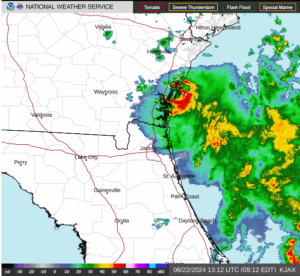Major Hurricane Beryl neared Jamaica on Wednesday morning. At 11:00 a.m. EDT on Wednesday the center of Hurricane Beryl was located at latitude 17.1°N and longitude 76.1°W which put the center about 75 miles (120 km) southeast of Kingston, Jamaica. Beryl was moving toward the west-northwest at 18 m.p.h. (30 km/h). The maximum sustained wind speed was 145 m.p.h. (235 km/h) and there were wind gusts to 175 m.p.h. (280 km/h). The minimum surface pressure was 954 mb.
Hurricane Warnings were in effect for Jamaica, Grand Cayman, Little Cayman and Cayman Brac. A Hurricane Warning was also in effect for the portion of the coast from Puerto Costa Maya to Cancun, Mexico.
A Hurricane Watch was in effect for portion of the coast from Cabo Catoche to Cancun, Mexico. A Hurricane Watch was also in effect for the portion of the coast from Puerto Costa Maya to Chetumal, Mexico.
A Tropical Storm Warning was in effect for the south coast of Haiti from Anse d’Hainault to the border with the Dominican Republic. A Tropical Storm Warning was in effect for the portion of the coast from Cabo Catoche to Cancun, Mexico. A Tropical Storm Warning was also in effect for the portion of the coast from Puerto Costa Maya to Chetumal, Mexico.
A Tropical Storm Watch was in effect for the portion of the coast from Chetumal, Mexico to Belize City, Belize. A Tropical Storm Watch was also in effect for the portion of the coast from Cabo Catoche to Campeche, Mexico.
U.S. Air Force Reserve and NOAA aircraft found that Hurricane Beryl was still a major hurricane on Wednesday morning. Although the eye appeared cloud filled on visible satellite images, the reconnaissance aircraft reported a circular eye with a diameter of 23 miles (37 km) was present at the center of Beryl’s circulation. The eye was surrounded by a ring of thunderstorms and the strongest winds were occurring in that ring of storms. Bands of showers and thunderstorms were revolving around the core of Hurricane Beryl. Storms near the core generated strong upper level divergence that pumped mass away from the hurricane. Westerly winds in the upper levels of the atmosphere were inhibiting divergence of mass to the west of Hurricane Beryl. Since the removal of mass was less than the inflow of mass in the lower levels of the atmosphere, the surface pressure was increasing slowly.
The size of the circulation around Hurricane Beryl was nearly steady during Wednesday morning. Winds to hurricane force extended out 45 miles (75 km) from the center of Beryl’s circulation. Winds to tropical storm force extended out 185 miles (295 km) from the center of Hurricane Beryl.
The Hurricane Intensity Index (HII) for Hurricane Beryl was 29.9. The Hurricane Size Index (HSI) was 14.0 and the Hurricane Wind Intensity Size Index (HWISI) was 43.9. Hurricane Beryl was similar in size and intensity to Hurricane Ida when Ida hit Louisiana in 2021.
Hurricane Beryl will move through an environment that will be less favorable for a powerful hurricane during the next 24 hours. Beryl will move over water where the Sea Surface Temperatures are near 29°C. It will move under the southeastern part of an upper level low over Northwestern Caribbean Sea. The upper level low will produce westerly winds that will blow toward the top of Beryl’s circulation. Those winds will also cause the vertical wind shear to increase. Hurricane Beryl will weaken as the wind shear increases.
Hurricane Beryl will move around the southern side of a high pressure system over the western Atlantic Ocean. The high pressure system will steer Beryl toward the west-northwest during the next 24 hours. On its anticipated track, the center of Hurricane Beryl pass near the southern coast of Jamaica on Wednesday afternoon. Beryl will begin to affect the Cayman Islands later on Wednesday evening.
The core of Hurricane Beryl is likely to pass just south of Jamaica during the next few hours. Much of Jamaica could experience winds to hurricane force. The strongest winds will occur along the southern coast of Jamaica. Beryl will be capable of causing regional major damage. Widespread electricity outages are likely. Hurricane Beryl will also drop heavy rain on Jamaica. Heavy rain is likely to cause flash floods. Beryl could cause a storm surge of up to 13 feet (4 meters) along the south coast of Jamaica where the wind blows the water toward the coast.
Hurricane Beryl will reach the Cayman Islands on Wednesday night. Beryl is forecast still to be a hurricane when it reaches the Cayman Islands. Hurricane Beryl will be capable of causing regional serious damage when it reaches the Cayman Islands.
Hurricane Beryl will approach the Yucatan Peninsula on Thursday evening. Beryl is likely to still be a hurricane when it approaches the Yucatan.

